Strategic Cost Management Report: Lufthansa Company Evaluation
VerifiedAdded on 2020/05/04
|28
|6158
|71
Report
AI Summary
This report provides a comprehensive analysis of Lufthansa, examining its strategic cost management within the context of the global airline industry. The report begins with an overview of Lufthansa, including its mission, values, capabilities, and performance metrics. It then delves into a detailed PESTEL analysis, evaluating the political, economic, socio-cultural, technological, environmental, and legal factors impacting the company. Furthermore, the report utilizes Porter's Five Forces framework to assess the competitive landscape, including the threat of competition, new entrants, and substitutes. A key aspect of the analysis involves evaluating Lufthansa's strengths and weaknesses through financial performance, product/service portfolio, and core operations. The report concludes with an evaluation of Lufthansa's current strategies and provides recommendations regarding the company's share value, advising a 'hold' rating pending debt reduction and potential future purchase after debt minimization. The report highlights the deregulation of the global transport industries, fuel subsidies, debt burden, operating income, and the impact of new fleets and partnerships on the airline's efficacy.
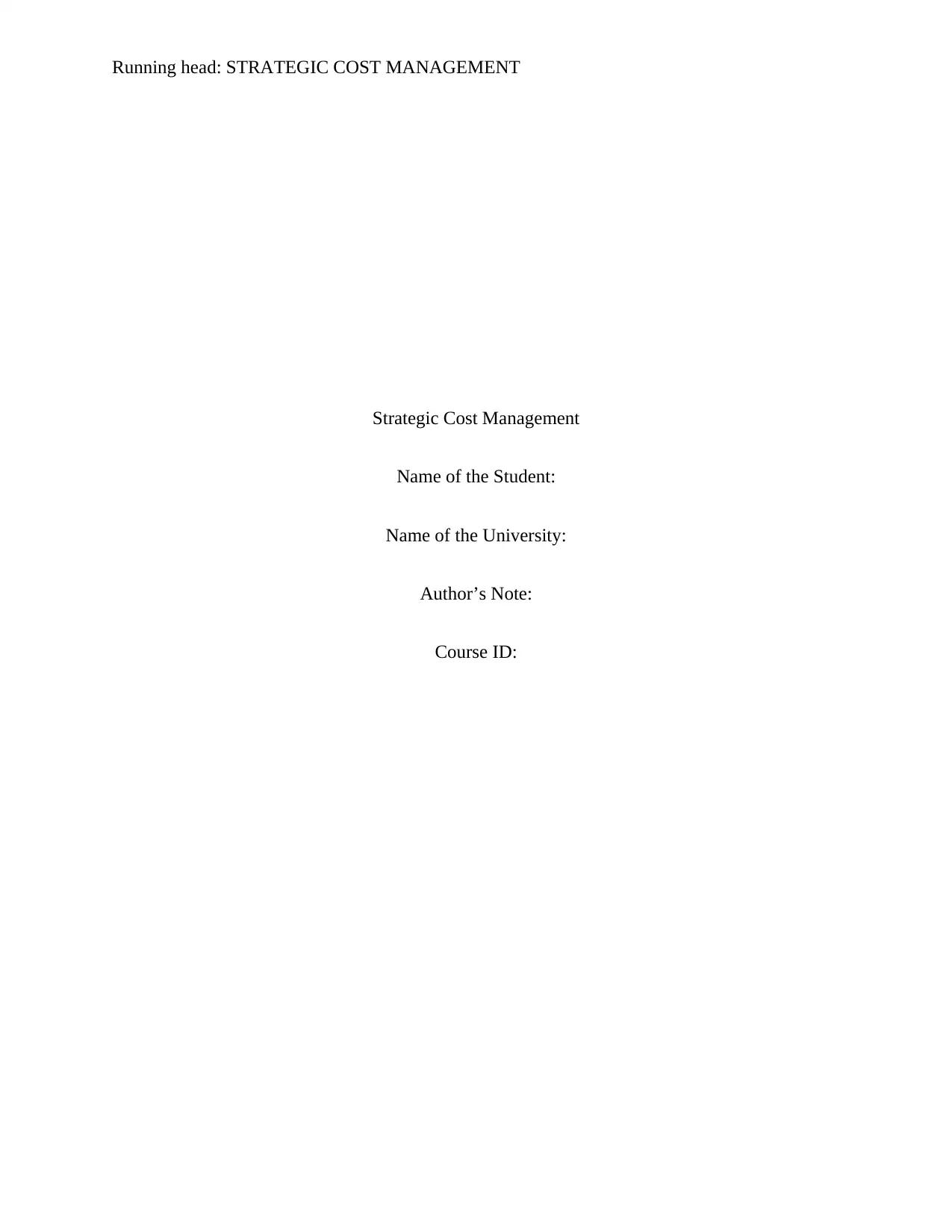
Running head: STRATEGIC COST MANAGEMENT
Strategic Cost Management
Name of the Student:
Name of the University:
Author’s Note:
Course ID:
Strategic Cost Management
Name of the Student:
Name of the University:
Author’s Note:
Course ID:
Paraphrase This Document
Need a fresh take? Get an instant paraphrase of this document with our AI Paraphraser
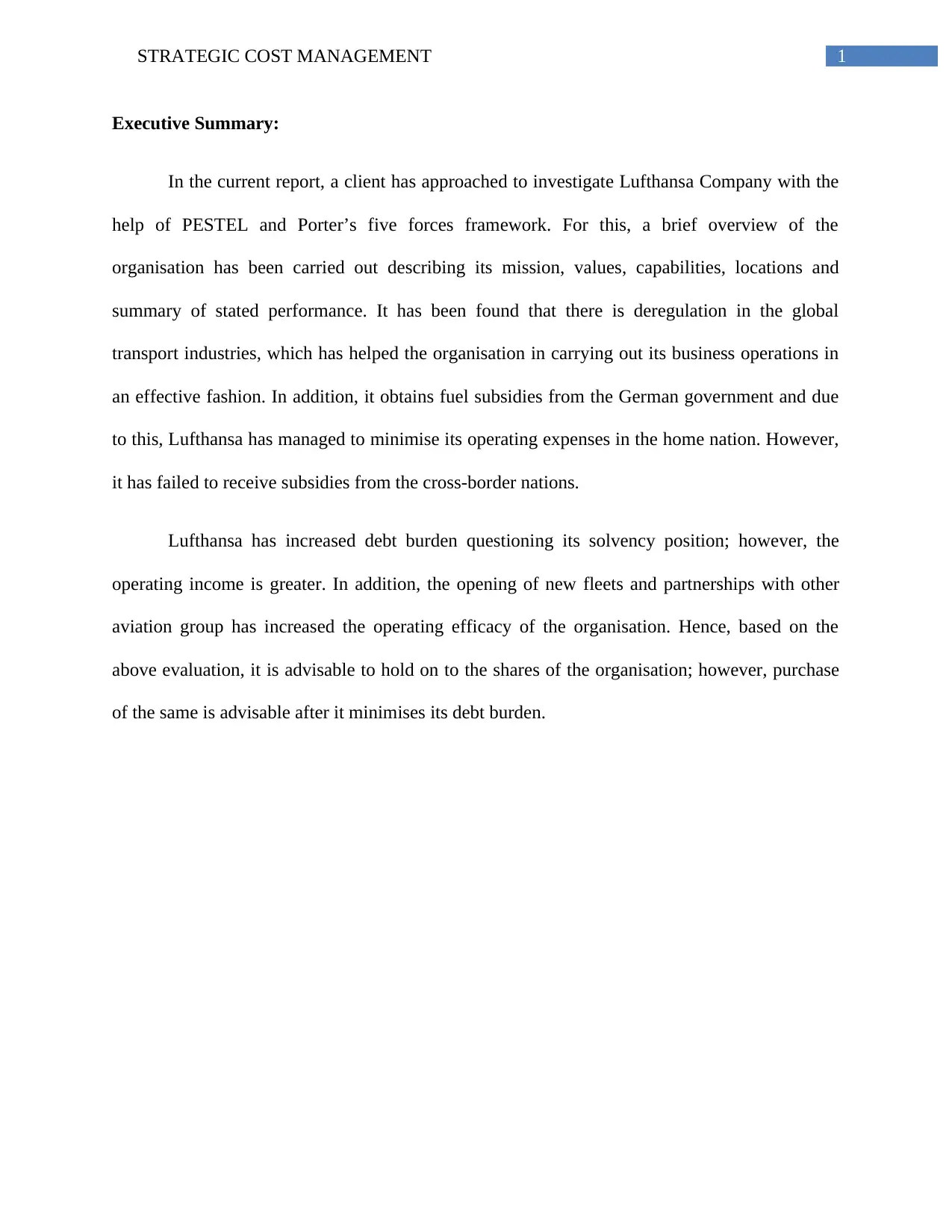
1STRATEGIC COST MANAGEMENT
Executive Summary:
In the current report, a client has approached to investigate Lufthansa Company with the
help of PESTEL and Porter’s five forces framework. For this, a brief overview of the
organisation has been carried out describing its mission, values, capabilities, locations and
summary of stated performance. It has been found that there is deregulation in the global
transport industries, which has helped the organisation in carrying out its business operations in
an effective fashion. In addition, it obtains fuel subsidies from the German government and due
to this, Lufthansa has managed to minimise its operating expenses in the home nation. However,
it has failed to receive subsidies from the cross-border nations.
Lufthansa has increased debt burden questioning its solvency position; however, the
operating income is greater. In addition, the opening of new fleets and partnerships with other
aviation group has increased the operating efficacy of the organisation. Hence, based on the
above evaluation, it is advisable to hold on to the shares of the organisation; however, purchase
of the same is advisable after it minimises its debt burden.
Executive Summary:
In the current report, a client has approached to investigate Lufthansa Company with the
help of PESTEL and Porter’s five forces framework. For this, a brief overview of the
organisation has been carried out describing its mission, values, capabilities, locations and
summary of stated performance. It has been found that there is deregulation in the global
transport industries, which has helped the organisation in carrying out its business operations in
an effective fashion. In addition, it obtains fuel subsidies from the German government and due
to this, Lufthansa has managed to minimise its operating expenses in the home nation. However,
it has failed to receive subsidies from the cross-border nations.
Lufthansa has increased debt burden questioning its solvency position; however, the
operating income is greater. In addition, the opening of new fleets and partnerships with other
aviation group has increased the operating efficacy of the organisation. Hence, based on the
above evaluation, it is advisable to hold on to the shares of the organisation; however, purchase
of the same is advisable after it minimises its debt burden.
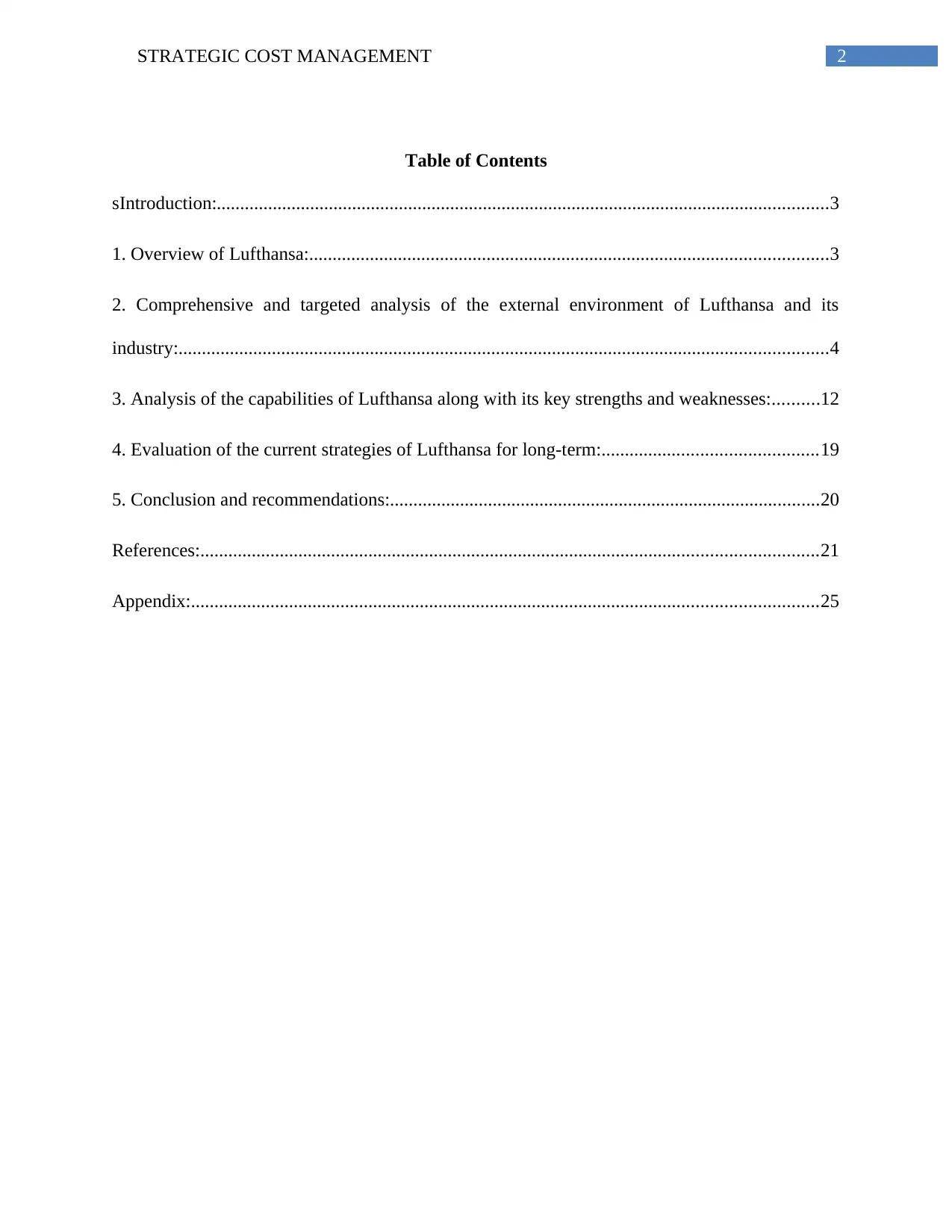
2STRATEGIC COST MANAGEMENT
Table of Contents
sIntroduction:...................................................................................................................................3
1. Overview of Lufthansa:...............................................................................................................3
2. Comprehensive and targeted analysis of the external environment of Lufthansa and its
industry:...........................................................................................................................................4
3. Analysis of the capabilities of Lufthansa along with its key strengths and weaknesses:..........12
4. Evaluation of the current strategies of Lufthansa for long-term:..............................................19
5. Conclusion and recommendations:............................................................................................20
References:....................................................................................................................................21
Appendix:......................................................................................................................................25
Table of Contents
sIntroduction:...................................................................................................................................3
1. Overview of Lufthansa:...............................................................................................................3
2. Comprehensive and targeted analysis of the external environment of Lufthansa and its
industry:...........................................................................................................................................4
3. Analysis of the capabilities of Lufthansa along with its key strengths and weaknesses:..........12
4. Evaluation of the current strategies of Lufthansa for long-term:..............................................19
5. Conclusion and recommendations:............................................................................................20
References:....................................................................................................................................21
Appendix:......................................................................................................................................25
⊘ This is a preview!⊘
Do you want full access?
Subscribe today to unlock all pages.

Trusted by 1+ million students worldwide
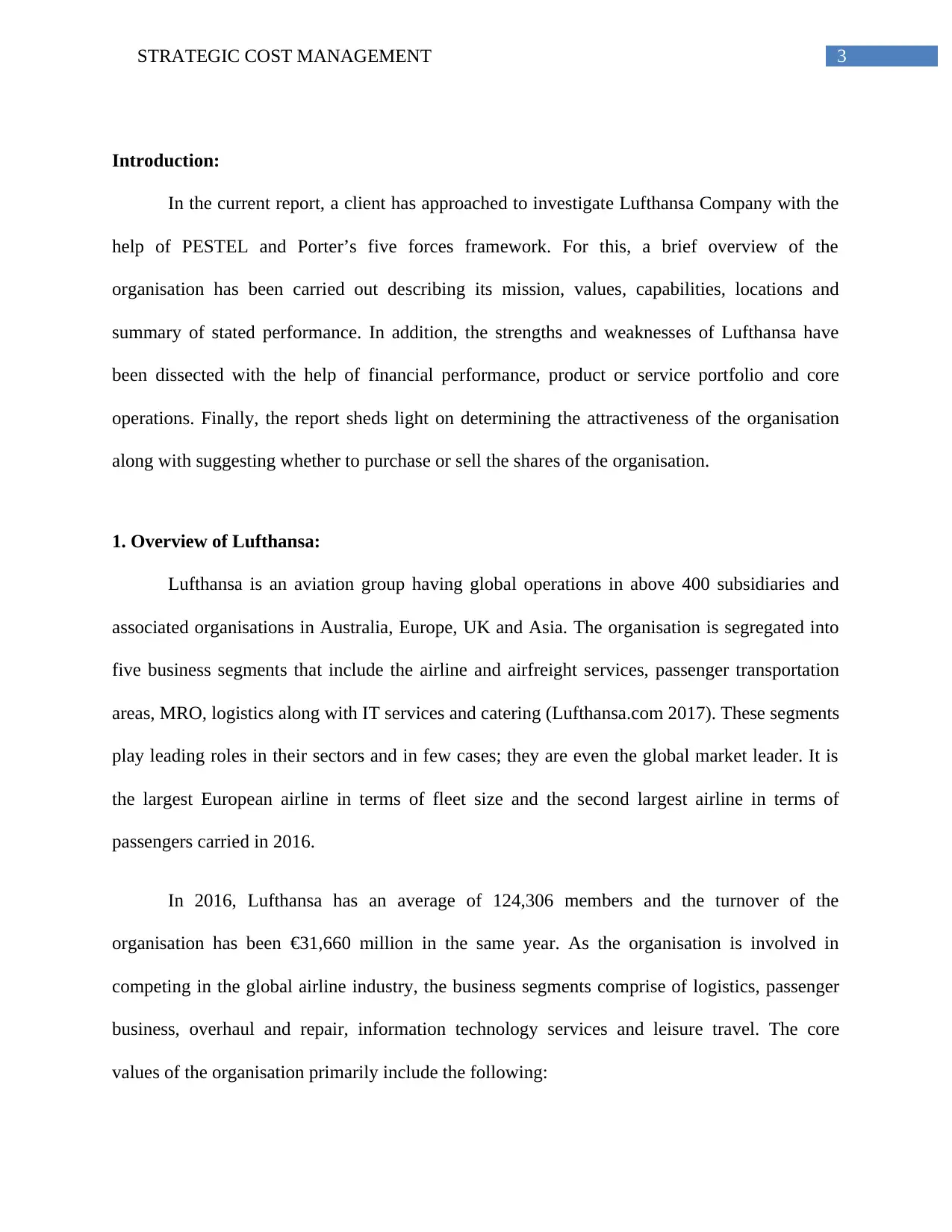
3STRATEGIC COST MANAGEMENT
Introduction:
In the current report, a client has approached to investigate Lufthansa Company with the
help of PESTEL and Porter’s five forces framework. For this, a brief overview of the
organisation has been carried out describing its mission, values, capabilities, locations and
summary of stated performance. In addition, the strengths and weaknesses of Lufthansa have
been dissected with the help of financial performance, product or service portfolio and core
operations. Finally, the report sheds light on determining the attractiveness of the organisation
along with suggesting whether to purchase or sell the shares of the organisation.
1. Overview of Lufthansa:
Lufthansa is an aviation group having global operations in above 400 subsidiaries and
associated organisations in Australia, Europe, UK and Asia. The organisation is segregated into
five business segments that include the airline and airfreight services, passenger transportation
areas, MRO, logistics along with IT services and catering (Lufthansa.com 2017). These segments
play leading roles in their sectors and in few cases; they are even the global market leader. It is
the largest European airline in terms of fleet size and the second largest airline in terms of
passengers carried in 2016.
In 2016, Lufthansa has an average of 124,306 members and the turnover of the
organisation has been €31,660 million in the same year. As the organisation is involved in
competing in the global airline industry, the business segments comprise of logistics, passenger
business, overhaul and repair, information technology services and leisure travel. The core
values of the organisation primarily include the following:
Introduction:
In the current report, a client has approached to investigate Lufthansa Company with the
help of PESTEL and Porter’s five forces framework. For this, a brief overview of the
organisation has been carried out describing its mission, values, capabilities, locations and
summary of stated performance. In addition, the strengths and weaknesses of Lufthansa have
been dissected with the help of financial performance, product or service portfolio and core
operations. Finally, the report sheds light on determining the attractiveness of the organisation
along with suggesting whether to purchase or sell the shares of the organisation.
1. Overview of Lufthansa:
Lufthansa is an aviation group having global operations in above 400 subsidiaries and
associated organisations in Australia, Europe, UK and Asia. The organisation is segregated into
five business segments that include the airline and airfreight services, passenger transportation
areas, MRO, logistics along with IT services and catering (Lufthansa.com 2017). These segments
play leading roles in their sectors and in few cases; they are even the global market leader. It is
the largest European airline in terms of fleet size and the second largest airline in terms of
passengers carried in 2016.
In 2016, Lufthansa has an average of 124,306 members and the turnover of the
organisation has been €31,660 million in the same year. As the organisation is involved in
competing in the global airline industry, the business segments comprise of logistics, passenger
business, overhaul and repair, information technology services and leisure travel. The core
values of the organisation primarily include the following:
Paraphrase This Document
Need a fresh take? Get an instant paraphrase of this document with our AI Paraphraser
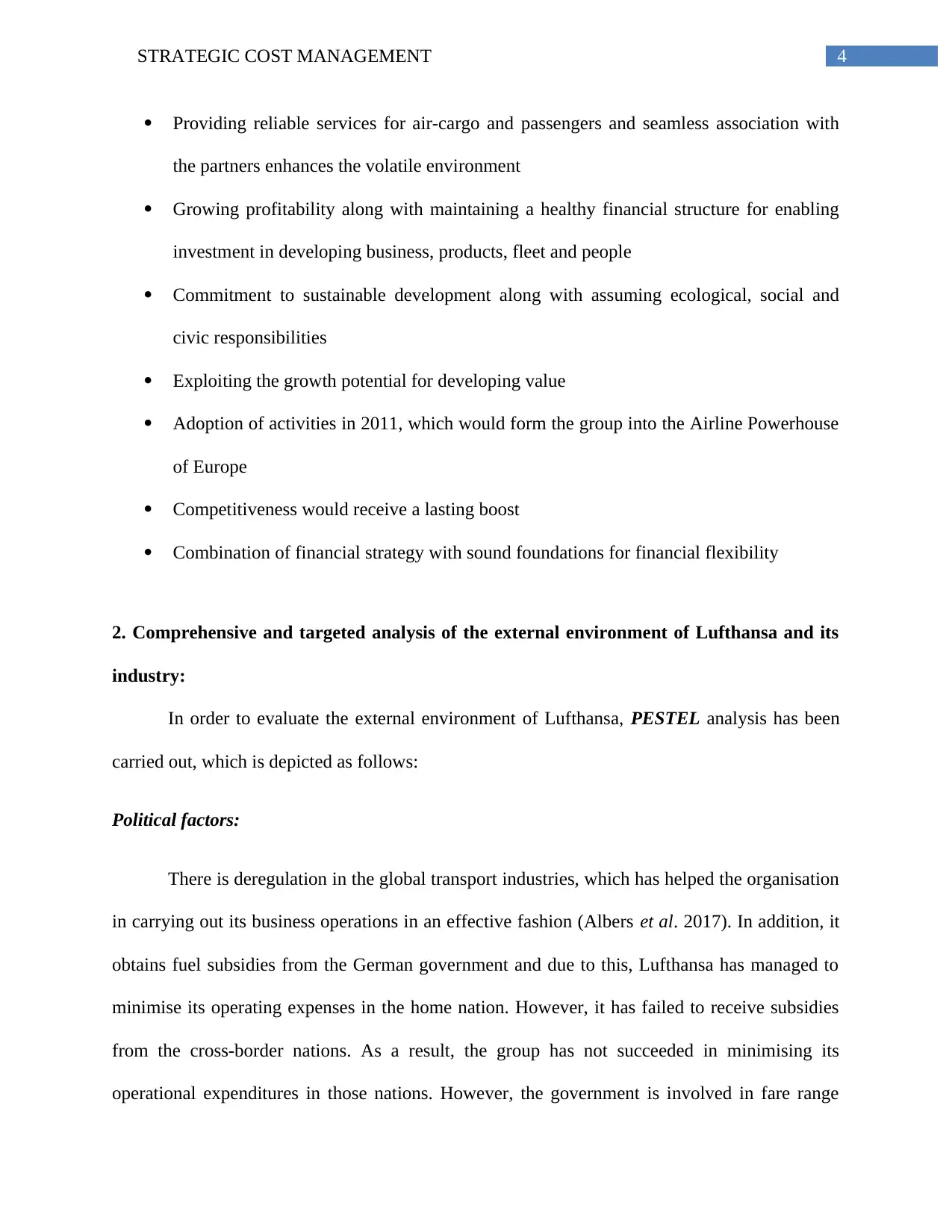
4STRATEGIC COST MANAGEMENT
Providing reliable services for air-cargo and passengers and seamless association with
the partners enhances the volatile environment
Growing profitability along with maintaining a healthy financial structure for enabling
investment in developing business, products, fleet and people
Commitment to sustainable development along with assuming ecological, social and
civic responsibilities
Exploiting the growth potential for developing value
Adoption of activities in 2011, which would form the group into the Airline Powerhouse
of Europe
Competitiveness would receive a lasting boost
Combination of financial strategy with sound foundations for financial flexibility
2. Comprehensive and targeted analysis of the external environment of Lufthansa and its
industry:
In order to evaluate the external environment of Lufthansa, PESTEL analysis has been
carried out, which is depicted as follows:
Political factors:
There is deregulation in the global transport industries, which has helped the organisation
in carrying out its business operations in an effective fashion (Albers et al. 2017). In addition, it
obtains fuel subsidies from the German government and due to this, Lufthansa has managed to
minimise its operating expenses in the home nation. However, it has failed to receive subsidies
from the cross-border nations. As a result, the group has not succeeded in minimising its
operational expenditures in those nations. However, the government is involved in fare range
Providing reliable services for air-cargo and passengers and seamless association with
the partners enhances the volatile environment
Growing profitability along with maintaining a healthy financial structure for enabling
investment in developing business, products, fleet and people
Commitment to sustainable development along with assuming ecological, social and
civic responsibilities
Exploiting the growth potential for developing value
Adoption of activities in 2011, which would form the group into the Airline Powerhouse
of Europe
Competitiveness would receive a lasting boost
Combination of financial strategy with sound foundations for financial flexibility
2. Comprehensive and targeted analysis of the external environment of Lufthansa and its
industry:
In order to evaluate the external environment of Lufthansa, PESTEL analysis has been
carried out, which is depicted as follows:
Political factors:
There is deregulation in the global transport industries, which has helped the organisation
in carrying out its business operations in an effective fashion (Albers et al. 2017). In addition, it
obtains fuel subsidies from the German government and due to this, Lufthansa has managed to
minimise its operating expenses in the home nation. However, it has failed to receive subsidies
from the cross-border nations. As a result, the group has not succeeded in minimising its
operational expenditures in those nations. However, the government is involved in fare range
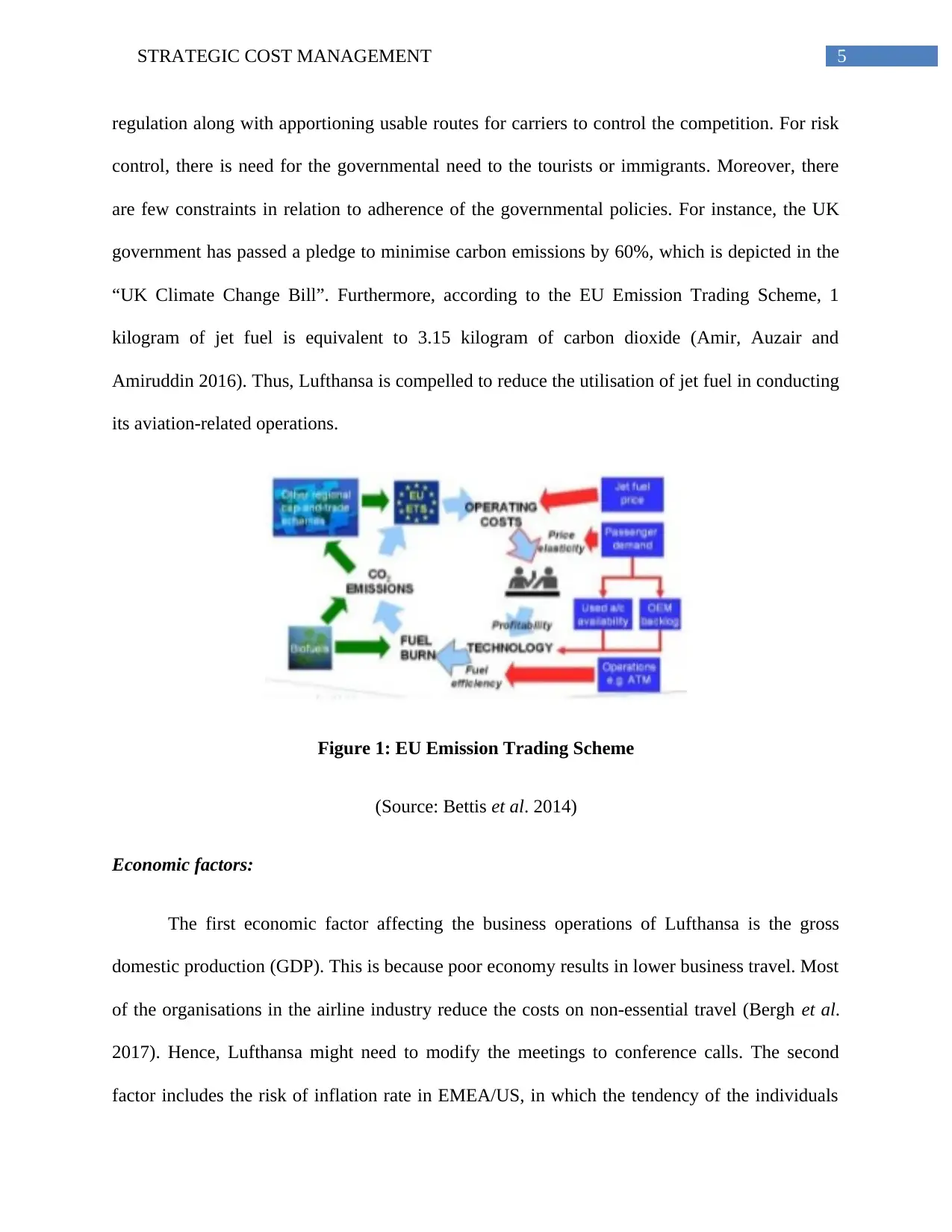
5STRATEGIC COST MANAGEMENT
regulation along with apportioning usable routes for carriers to control the competition. For risk
control, there is need for the governmental need to the tourists or immigrants. Moreover, there
are few constraints in relation to adherence of the governmental policies. For instance, the UK
government has passed a pledge to minimise carbon emissions by 60%, which is depicted in the
“UK Climate Change Bill”. Furthermore, according to the EU Emission Trading Scheme, 1
kilogram of jet fuel is equivalent to 3.15 kilogram of carbon dioxide (Amir, Auzair and
Amiruddin 2016). Thus, Lufthansa is compelled to reduce the utilisation of jet fuel in conducting
its aviation-related operations.
Figure 1: EU Emission Trading Scheme
(Source: Bettis et al. 2014)
Economic factors:
The first economic factor affecting the business operations of Lufthansa is the gross
domestic production (GDP). This is because poor economy results in lower business travel. Most
of the organisations in the airline industry reduce the costs on non-essential travel (Bergh et al.
2017). Hence, Lufthansa might need to modify the meetings to conference calls. The second
factor includes the risk of inflation rate in EMEA/US, in which the tendency of the individuals
regulation along with apportioning usable routes for carriers to control the competition. For risk
control, there is need for the governmental need to the tourists or immigrants. Moreover, there
are few constraints in relation to adherence of the governmental policies. For instance, the UK
government has passed a pledge to minimise carbon emissions by 60%, which is depicted in the
“UK Climate Change Bill”. Furthermore, according to the EU Emission Trading Scheme, 1
kilogram of jet fuel is equivalent to 3.15 kilogram of carbon dioxide (Amir, Auzair and
Amiruddin 2016). Thus, Lufthansa is compelled to reduce the utilisation of jet fuel in conducting
its aviation-related operations.
Figure 1: EU Emission Trading Scheme
(Source: Bettis et al. 2014)
Economic factors:
The first economic factor affecting the business operations of Lufthansa is the gross
domestic production (GDP). This is because poor economy results in lower business travel. Most
of the organisations in the airline industry reduce the costs on non-essential travel (Bergh et al.
2017). Hence, Lufthansa might need to modify the meetings to conference calls. The second
factor includes the risk of inflation rate in EMEA/US, in which the tendency of the individuals
⊘ This is a preview!⊘
Do you want full access?
Subscribe today to unlock all pages.

Trusted by 1+ million students worldwide
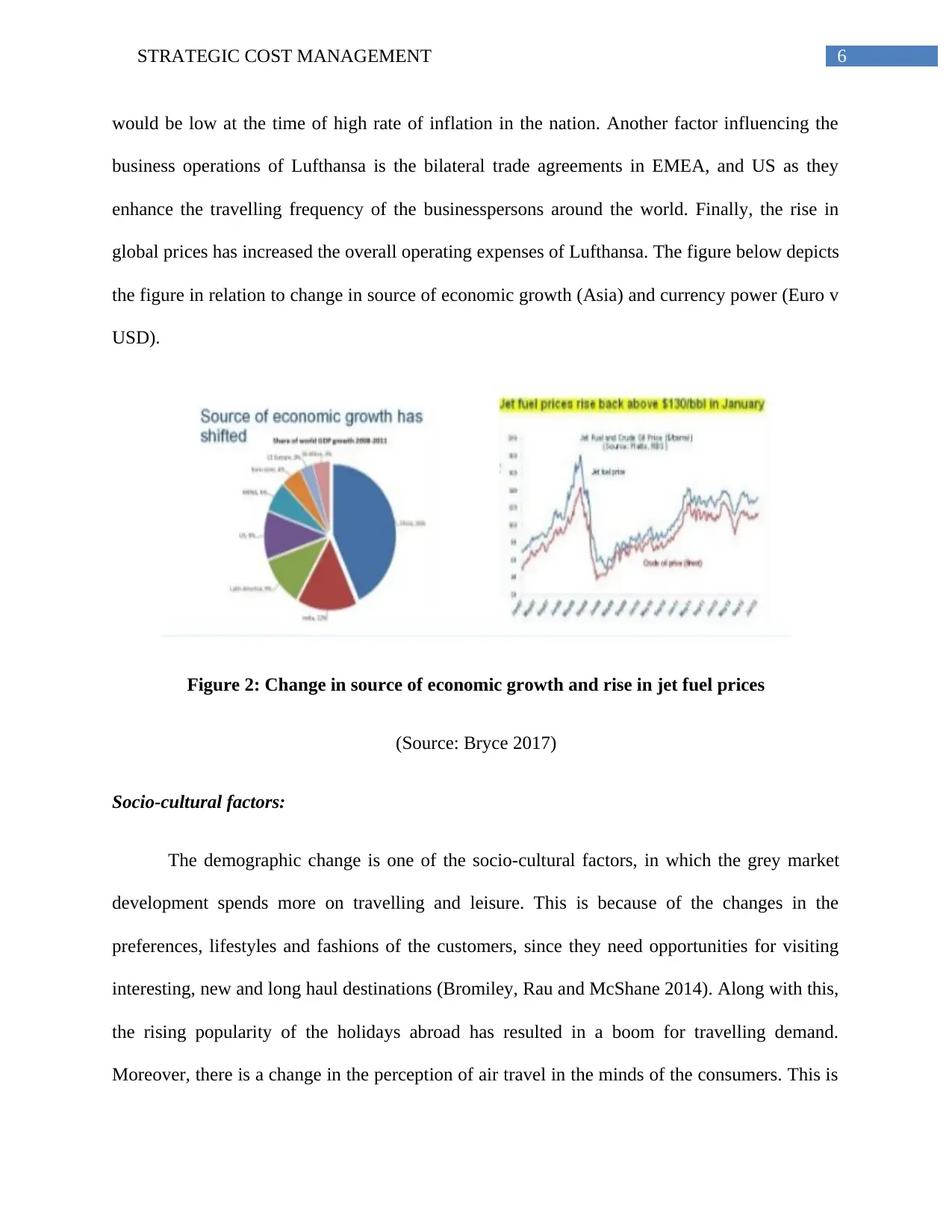
6STRATEGIC COST MANAGEMENT
would be low at the time of high rate of inflation in the nation. Another factor influencing the
business operations of Lufthansa is the bilateral trade agreements in EMEA, and US as they
enhance the travelling frequency of the businesspersons around the world. Finally, the rise in
global prices has increased the overall operating expenses of Lufthansa. The figure below depicts
the figure in relation to change in source of economic growth (Asia) and currency power (Euro v
USD).
Figure 2: Change in source of economic growth and rise in jet fuel prices
(Source: Bryce 2017)
Socio-cultural factors:
The demographic change is one of the socio-cultural factors, in which the grey market
development spends more on travelling and leisure. This is because of the changes in the
preferences, lifestyles and fashions of the customers, since they need opportunities for visiting
interesting, new and long haul destinations (Bromiley, Rau and McShane 2014). Along with this,
the rising popularity of the holidays abroad has resulted in a boom for travelling demand.
Moreover, there is a change in the perception of air travel in the minds of the consumers. This is
would be low at the time of high rate of inflation in the nation. Another factor influencing the
business operations of Lufthansa is the bilateral trade agreements in EMEA, and US as they
enhance the travelling frequency of the businesspersons around the world. Finally, the rise in
global prices has increased the overall operating expenses of Lufthansa. The figure below depicts
the figure in relation to change in source of economic growth (Asia) and currency power (Euro v
USD).
Figure 2: Change in source of economic growth and rise in jet fuel prices
(Source: Bryce 2017)
Socio-cultural factors:
The demographic change is one of the socio-cultural factors, in which the grey market
development spends more on travelling and leisure. This is because of the changes in the
preferences, lifestyles and fashions of the customers, since they need opportunities for visiting
interesting, new and long haul destinations (Bromiley, Rau and McShane 2014). Along with this,
the rising popularity of the holidays abroad has resulted in a boom for travelling demand.
Moreover, there is a change in the perception of air travel in the minds of the consumers. This is
Paraphrase This Document
Need a fresh take? Get an instant paraphrase of this document with our AI Paraphraser
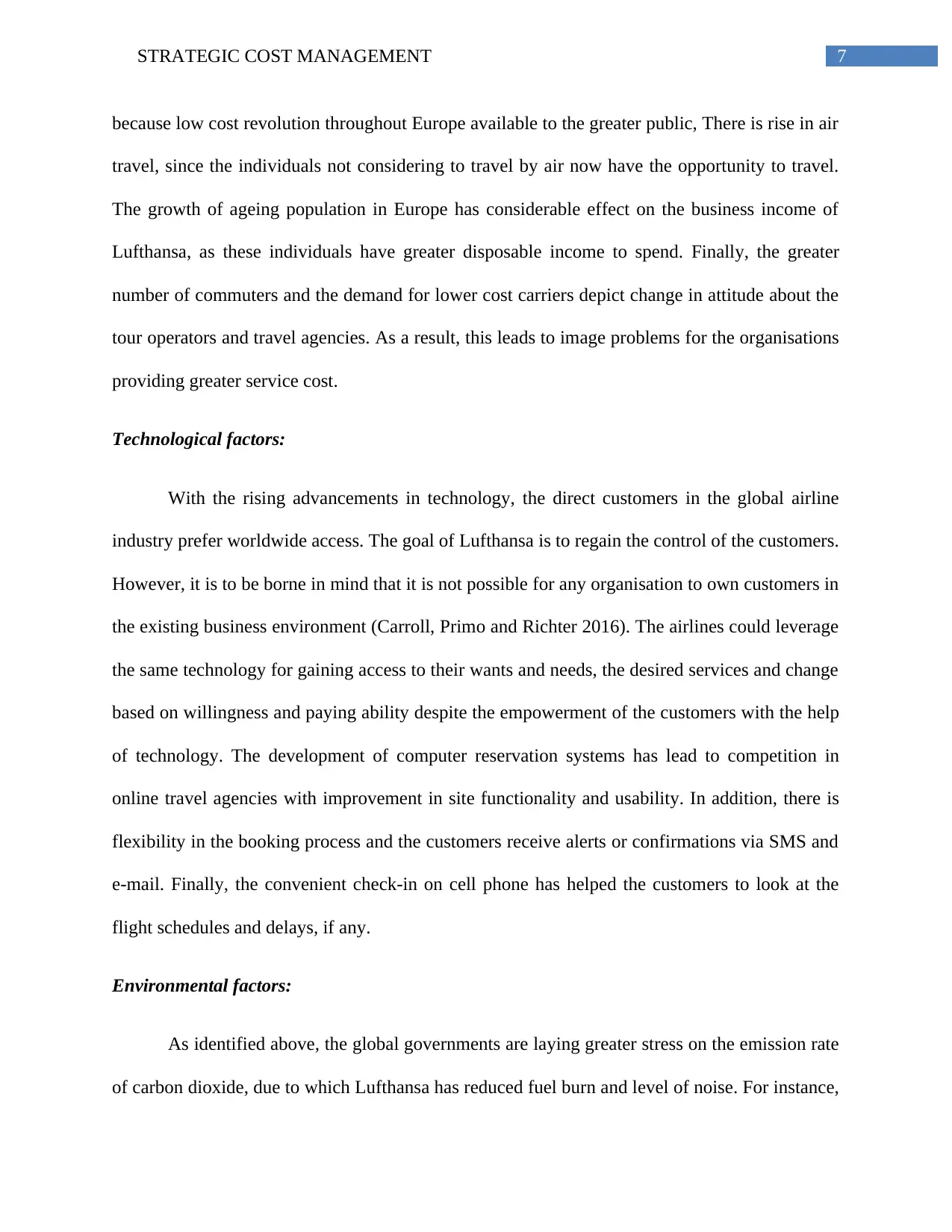
7STRATEGIC COST MANAGEMENT
because low cost revolution throughout Europe available to the greater public, There is rise in air
travel, since the individuals not considering to travel by air now have the opportunity to travel.
The growth of ageing population in Europe has considerable effect on the business income of
Lufthansa, as these individuals have greater disposable income to spend. Finally, the greater
number of commuters and the demand for lower cost carriers depict change in attitude about the
tour operators and travel agencies. As a result, this leads to image problems for the organisations
providing greater service cost.
Technological factors:
With the rising advancements in technology, the direct customers in the global airline
industry prefer worldwide access. The goal of Lufthansa is to regain the control of the customers.
However, it is to be borne in mind that it is not possible for any organisation to own customers in
the existing business environment (Carroll, Primo and Richter 2016). The airlines could leverage
the same technology for gaining access to their wants and needs, the desired services and change
based on willingness and paying ability despite the empowerment of the customers with the help
of technology. The development of computer reservation systems has lead to competition in
online travel agencies with improvement in site functionality and usability. In addition, there is
flexibility in the booking process and the customers receive alerts or confirmations via SMS and
e-mail. Finally, the convenient check-in on cell phone has helped the customers to look at the
flight schedules and delays, if any.
Environmental factors:
As identified above, the global governments are laying greater stress on the emission rate
of carbon dioxide, due to which Lufthansa has reduced fuel burn and level of noise. For instance,
because low cost revolution throughout Europe available to the greater public, There is rise in air
travel, since the individuals not considering to travel by air now have the opportunity to travel.
The growth of ageing population in Europe has considerable effect on the business income of
Lufthansa, as these individuals have greater disposable income to spend. Finally, the greater
number of commuters and the demand for lower cost carriers depict change in attitude about the
tour operators and travel agencies. As a result, this leads to image problems for the organisations
providing greater service cost.
Technological factors:
With the rising advancements in technology, the direct customers in the global airline
industry prefer worldwide access. The goal of Lufthansa is to regain the control of the customers.
However, it is to be borne in mind that it is not possible for any organisation to own customers in
the existing business environment (Carroll, Primo and Richter 2016). The airlines could leverage
the same technology for gaining access to their wants and needs, the desired services and change
based on willingness and paying ability despite the empowerment of the customers with the help
of technology. The development of computer reservation systems has lead to competition in
online travel agencies with improvement in site functionality and usability. In addition, there is
flexibility in the booking process and the customers receive alerts or confirmations via SMS and
e-mail. Finally, the convenient check-in on cell phone has helped the customers to look at the
flight schedules and delays, if any.
Environmental factors:
As identified above, the global governments are laying greater stress on the emission rate
of carbon dioxide, due to which Lufthansa has reduced fuel burn and level of noise. For instance,
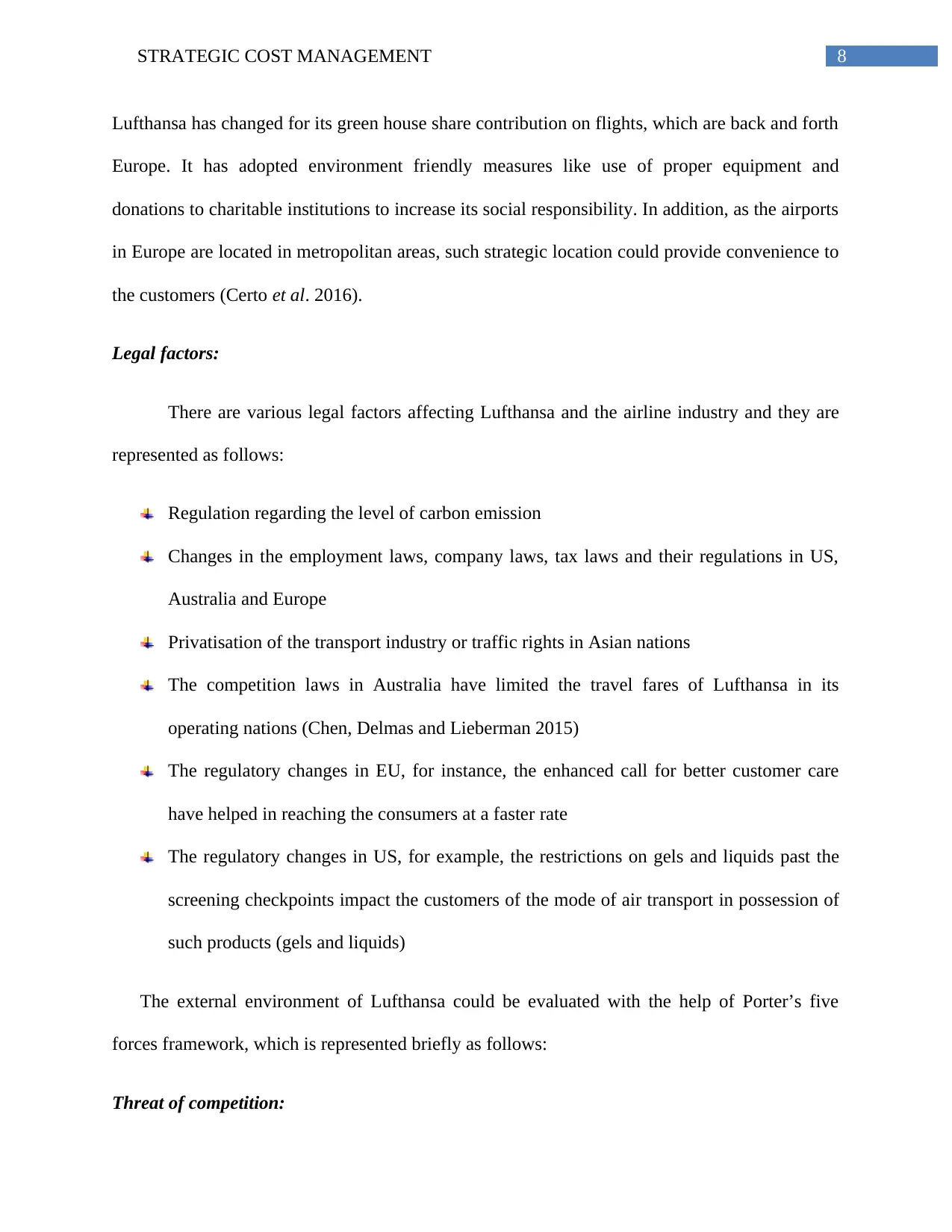
8STRATEGIC COST MANAGEMENT
Lufthansa has changed for its green house share contribution on flights, which are back and forth
Europe. It has adopted environment friendly measures like use of proper equipment and
donations to charitable institutions to increase its social responsibility. In addition, as the airports
in Europe are located in metropolitan areas, such strategic location could provide convenience to
the customers (Certo et al. 2016).
Legal factors:
There are various legal factors affecting Lufthansa and the airline industry and they are
represented as follows:
Regulation regarding the level of carbon emission
Changes in the employment laws, company laws, tax laws and their regulations in US,
Australia and Europe
Privatisation of the transport industry or traffic rights in Asian nations
The competition laws in Australia have limited the travel fares of Lufthansa in its
operating nations (Chen, Delmas and Lieberman 2015)
The regulatory changes in EU, for instance, the enhanced call for better customer care
have helped in reaching the consumers at a faster rate
The regulatory changes in US, for example, the restrictions on gels and liquids past the
screening checkpoints impact the customers of the mode of air transport in possession of
such products (gels and liquids)
The external environment of Lufthansa could be evaluated with the help of Porter’s five
forces framework, which is represented briefly as follows:
Threat of competition:
Lufthansa has changed for its green house share contribution on flights, which are back and forth
Europe. It has adopted environment friendly measures like use of proper equipment and
donations to charitable institutions to increase its social responsibility. In addition, as the airports
in Europe are located in metropolitan areas, such strategic location could provide convenience to
the customers (Certo et al. 2016).
Legal factors:
There are various legal factors affecting Lufthansa and the airline industry and they are
represented as follows:
Regulation regarding the level of carbon emission
Changes in the employment laws, company laws, tax laws and their regulations in US,
Australia and Europe
Privatisation of the transport industry or traffic rights in Asian nations
The competition laws in Australia have limited the travel fares of Lufthansa in its
operating nations (Chen, Delmas and Lieberman 2015)
The regulatory changes in EU, for instance, the enhanced call for better customer care
have helped in reaching the consumers at a faster rate
The regulatory changes in US, for example, the restrictions on gels and liquids past the
screening checkpoints impact the customers of the mode of air transport in possession of
such products (gels and liquids)
The external environment of Lufthansa could be evaluated with the help of Porter’s five
forces framework, which is represented briefly as follows:
Threat of competition:
⊘ This is a preview!⊘
Do you want full access?
Subscribe today to unlock all pages.

Trusted by 1+ million students worldwide
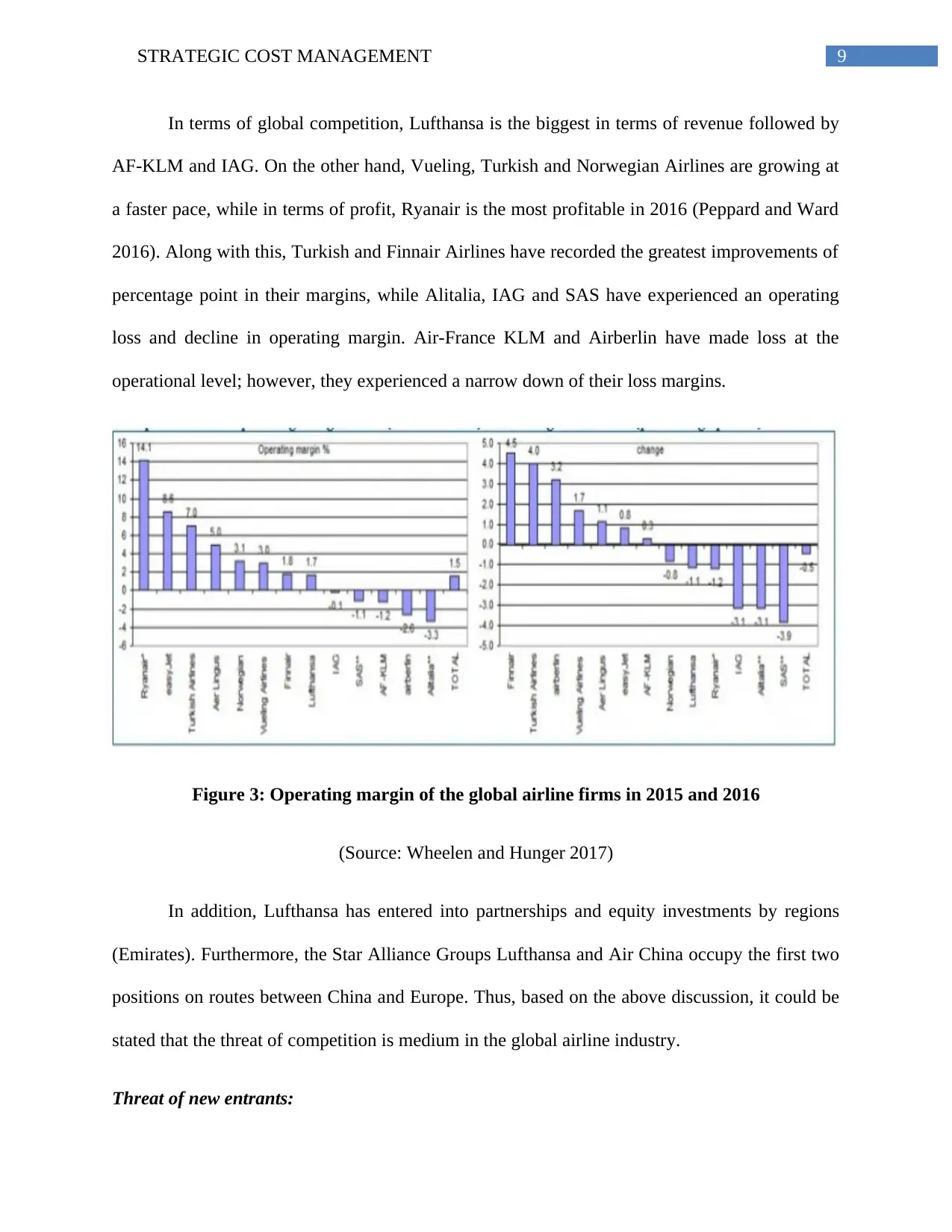
9STRATEGIC COST MANAGEMENT
In terms of global competition, Lufthansa is the biggest in terms of revenue followed by
AF-KLM and IAG. On the other hand, Vueling, Turkish and Norwegian Airlines are growing at
a faster pace, while in terms of profit, Ryanair is the most profitable in 2016 (Peppard and Ward
2016). Along with this, Turkish and Finnair Airlines have recorded the greatest improvements of
percentage point in their margins, while Alitalia, IAG and SAS have experienced an operating
loss and decline in operating margin. Air-France KLM and Airberlin have made loss at the
operational level; however, they experienced a narrow down of their loss margins.
Figure 3: Operating margin of the global airline firms in 2015 and 2016
(Source: Wheelen and Hunger 2017)
In addition, Lufthansa has entered into partnerships and equity investments by regions
(Emirates). Furthermore, the Star Alliance Groups Lufthansa and Air China occupy the first two
positions on routes between China and Europe. Thus, based on the above discussion, it could be
stated that the threat of competition is medium in the global airline industry.
Threat of new entrants:
In terms of global competition, Lufthansa is the biggest in terms of revenue followed by
AF-KLM and IAG. On the other hand, Vueling, Turkish and Norwegian Airlines are growing at
a faster pace, while in terms of profit, Ryanair is the most profitable in 2016 (Peppard and Ward
2016). Along with this, Turkish and Finnair Airlines have recorded the greatest improvements of
percentage point in their margins, while Alitalia, IAG and SAS have experienced an operating
loss and decline in operating margin. Air-France KLM and Airberlin have made loss at the
operational level; however, they experienced a narrow down of their loss margins.
Figure 3: Operating margin of the global airline firms in 2015 and 2016
(Source: Wheelen and Hunger 2017)
In addition, Lufthansa has entered into partnerships and equity investments by regions
(Emirates). Furthermore, the Star Alliance Groups Lufthansa and Air China occupy the first two
positions on routes between China and Europe. Thus, based on the above discussion, it could be
stated that the threat of competition is medium in the global airline industry.
Threat of new entrants:
Paraphrase This Document
Need a fresh take? Get an instant paraphrase of this document with our AI Paraphraser
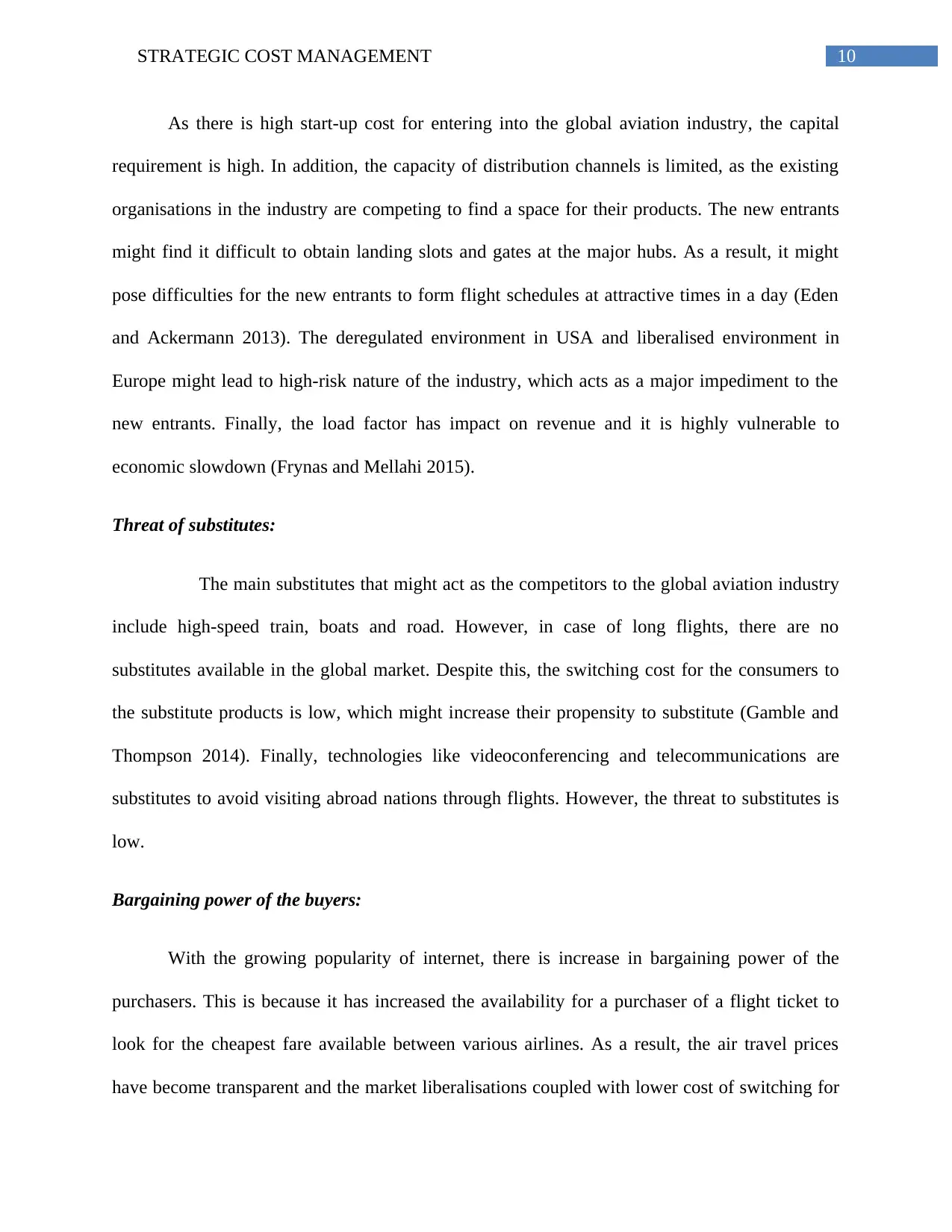
10STRATEGIC COST MANAGEMENT
As there is high start-up cost for entering into the global aviation industry, the capital
requirement is high. In addition, the capacity of distribution channels is limited, as the existing
organisations in the industry are competing to find a space for their products. The new entrants
might find it difficult to obtain landing slots and gates at the major hubs. As a result, it might
pose difficulties for the new entrants to form flight schedules at attractive times in a day (Eden
and Ackermann 2013). The deregulated environment in USA and liberalised environment in
Europe might lead to high-risk nature of the industry, which acts as a major impediment to the
new entrants. Finally, the load factor has impact on revenue and it is highly vulnerable to
economic slowdown (Frynas and Mellahi 2015).
Threat of substitutes:
The main substitutes that might act as the competitors to the global aviation industry
include high-speed train, boats and road. However, in case of long flights, there are no
substitutes available in the global market. Despite this, the switching cost for the consumers to
the substitute products is low, which might increase their propensity to substitute (Gamble and
Thompson 2014). Finally, technologies like videoconferencing and telecommunications are
substitutes to avoid visiting abroad nations through flights. However, the threat to substitutes is
low.
Bargaining power of the buyers:
With the growing popularity of internet, there is increase in bargaining power of the
purchasers. This is because it has increased the availability for a purchaser of a flight ticket to
look for the cheapest fare available between various airlines. As a result, the air travel prices
have become transparent and the market liberalisations coupled with lower cost of switching for
As there is high start-up cost for entering into the global aviation industry, the capital
requirement is high. In addition, the capacity of distribution channels is limited, as the existing
organisations in the industry are competing to find a space for their products. The new entrants
might find it difficult to obtain landing slots and gates at the major hubs. As a result, it might
pose difficulties for the new entrants to form flight schedules at attractive times in a day (Eden
and Ackermann 2013). The deregulated environment in USA and liberalised environment in
Europe might lead to high-risk nature of the industry, which acts as a major impediment to the
new entrants. Finally, the load factor has impact on revenue and it is highly vulnerable to
economic slowdown (Frynas and Mellahi 2015).
Threat of substitutes:
The main substitutes that might act as the competitors to the global aviation industry
include high-speed train, boats and road. However, in case of long flights, there are no
substitutes available in the global market. Despite this, the switching cost for the consumers to
the substitute products is low, which might increase their propensity to substitute (Gamble and
Thompson 2014). Finally, technologies like videoconferencing and telecommunications are
substitutes to avoid visiting abroad nations through flights. However, the threat to substitutes is
low.
Bargaining power of the buyers:
With the growing popularity of internet, there is increase in bargaining power of the
purchasers. This is because it has increased the availability for a purchaser of a flight ticket to
look for the cheapest fare available between various airlines. As a result, the air travel prices
have become transparent and the market liberalisations coupled with lower cost of switching for
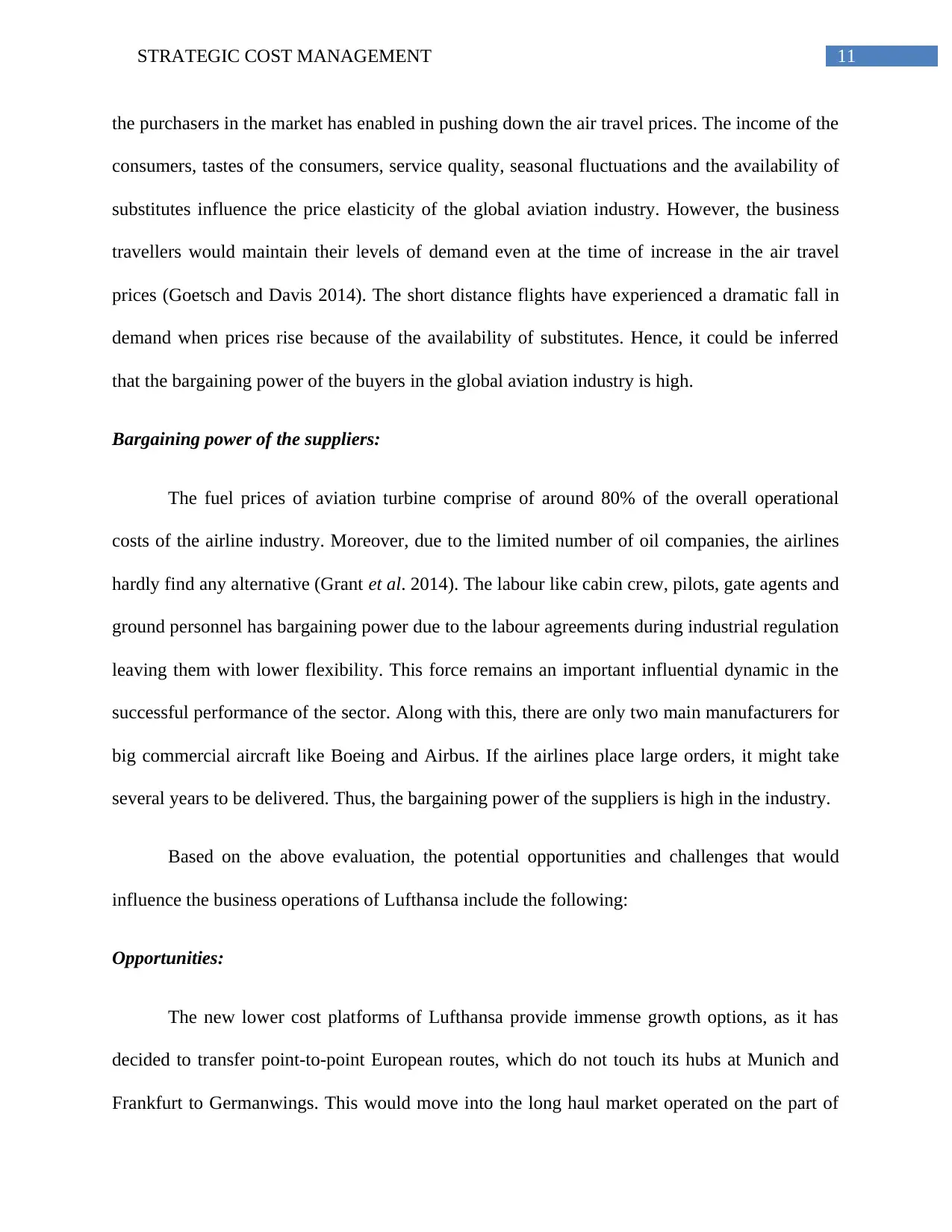
11STRATEGIC COST MANAGEMENT
the purchasers in the market has enabled in pushing down the air travel prices. The income of the
consumers, tastes of the consumers, service quality, seasonal fluctuations and the availability of
substitutes influence the price elasticity of the global aviation industry. However, the business
travellers would maintain their levels of demand even at the time of increase in the air travel
prices (Goetsch and Davis 2014). The short distance flights have experienced a dramatic fall in
demand when prices rise because of the availability of substitutes. Hence, it could be inferred
that the bargaining power of the buyers in the global aviation industry is high.
Bargaining power of the suppliers:
The fuel prices of aviation turbine comprise of around 80% of the overall operational
costs of the airline industry. Moreover, due to the limited number of oil companies, the airlines
hardly find any alternative (Grant et al. 2014). The labour like cabin crew, pilots, gate agents and
ground personnel has bargaining power due to the labour agreements during industrial regulation
leaving them with lower flexibility. This force remains an important influential dynamic in the
successful performance of the sector. Along with this, there are only two main manufacturers for
big commercial aircraft like Boeing and Airbus. If the airlines place large orders, it might take
several years to be delivered. Thus, the bargaining power of the suppliers is high in the industry.
Based on the above evaluation, the potential opportunities and challenges that would
influence the business operations of Lufthansa include the following:
Opportunities:
The new lower cost platforms of Lufthansa provide immense growth options, as it has
decided to transfer point-to-point European routes, which do not touch its hubs at Munich and
Frankfurt to Germanwings. This would move into the long haul market operated on the part of
the purchasers in the market has enabled in pushing down the air travel prices. The income of the
consumers, tastes of the consumers, service quality, seasonal fluctuations and the availability of
substitutes influence the price elasticity of the global aviation industry. However, the business
travellers would maintain their levels of demand even at the time of increase in the air travel
prices (Goetsch and Davis 2014). The short distance flights have experienced a dramatic fall in
demand when prices rise because of the availability of substitutes. Hence, it could be inferred
that the bargaining power of the buyers in the global aviation industry is high.
Bargaining power of the suppliers:
The fuel prices of aviation turbine comprise of around 80% of the overall operational
costs of the airline industry. Moreover, due to the limited number of oil companies, the airlines
hardly find any alternative (Grant et al. 2014). The labour like cabin crew, pilots, gate agents and
ground personnel has bargaining power due to the labour agreements during industrial regulation
leaving them with lower flexibility. This force remains an important influential dynamic in the
successful performance of the sector. Along with this, there are only two main manufacturers for
big commercial aircraft like Boeing and Airbus. If the airlines place large orders, it might take
several years to be delivered. Thus, the bargaining power of the suppliers is high in the industry.
Based on the above evaluation, the potential opportunities and challenges that would
influence the business operations of Lufthansa include the following:
Opportunities:
The new lower cost platforms of Lufthansa provide immense growth options, as it has
decided to transfer point-to-point European routes, which do not touch its hubs at Munich and
Frankfurt to Germanwings. This would move into the long haul market operated on the part of
⊘ This is a preview!⊘
Do you want full access?
Subscribe today to unlock all pages.

Trusted by 1+ million students worldwide
1 out of 28
Related Documents
Your All-in-One AI-Powered Toolkit for Academic Success.
+13062052269
info@desklib.com
Available 24*7 on WhatsApp / Email
![[object Object]](/_next/static/media/star-bottom.7253800d.svg)
Unlock your academic potential
Copyright © 2020–2025 A2Z Services. All Rights Reserved. Developed and managed by ZUCOL.





